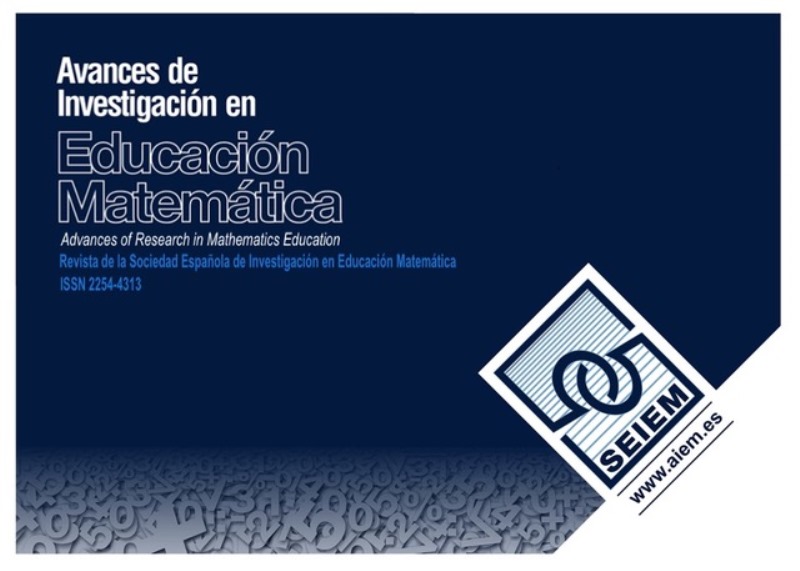Problem Posing as a Framework to Invent Games that Stimulate Mathematical Thinking
DOI:
https://doi.org/10.35763/aiem28.7521Keywords:
Affective behavior, Game creation, Problem posing, Primary education, Probabilistic thinkingAbstract
Researchers in psychology emphasize the importance of games during children’s learning and development processes; on the other hand, researchers in mathematics education emphasize the importance of problem posing in mathematics learning. This leads us to integrate both points of view and explore game invention as a means to stimulate probabilistic thinking in children, using the framework of problem posing. In this sense, we qualitatively analyze the reactions of children in primary education when playing games invented by them, by modifying the rules of a game in one case and based on the material presented to them in another. Through the implemented processes, we found that inventing games using the problem posing framework helps stimulate probabilistic thinking in children.
Downloads
References
Alsina, Á., & Vásquez, C. (2024). La probabilidad en educación infantil: Finalidades, aplicaciones y prácticas de enseñanza. Ecociencia.
Baroody, A. J. (1987). Children’s mathematical thinking: A developmental framework for preschool, primary, and special education teachers. Teachers College Press.
Batanero, C. (2005). Significados de la probabilidad en la educación secundaria. RELIME, 8(3), 247–264.
Batanero, C., Álvarez-Arroyo, R., Hernández Solís, L. A., & Gea Serrano, M. M. (2021). El inicio del razonamiento probabilístico en educación infantil. PNA, 15(4), 267–288. https://doi.org/10.30827/pna.v15i4.22349
Batanero, C., & Chernoff, E. J. (Eds.). (2018). Teaching and learning stochastics: Advances in probability education research. Springer International.
Bonotto, C., & Dal Santo, L. (2015). On the relationship between problem posing, problem solving and creativity in the primary school. En F. Singer, N. Ellerton, & J. Cai (Eds.), Mathematical problem posing: From research to effective practice (pp. 103–124). Springer.
Cai, J., & Leikin, R. (2020). Affect in mathematical problem posing: Conceptualization, advances, and future directions for research. Educational Studies in Mathematics, 105(3), 287–301. https://doi.org/10.1007/s10649-020-10008-x
Cody, K. J., Rule, A. C., & Forsyth, B. R. (2015). Mathematical game creation and play assists students in practicing newly-learned challenging concepts. Creative Education, 6, 1484–1495. https://doi.org/10.4236/ce.2015.614149
Cohen, L., Manion, L., & Morrison, K. (2018). Research methods in education (8th ed.). Routledge.
Cheeseman, J. (2019). Young children are natural inquirers: Posing and solving mathematical problems. Waikato Journal of Education, 24(2), 11–22. https://doi.org/10.15663/wje.v24i2.664
Fischbein, E. (1975). The intuitive sources of probabilistic thinking in children. Reidel.
Gade, S., & Blomqvist, C. (2015). From problem posing to posing problems via explicit mediation in grades 4 and 5. En F. M. Singer, N. Ellerton, & J. Cai (Eds.), Mathematical problem posing: From research to effective practice (pp. 195–213). Springer.
Ginsburg, K. R. (2007). The importance of play in promoting healthy child development and maintaining strong parent–child bonds. Pediatrics, 119(1), 182–191.
Harding, J. (2024). The brain that loves to play: A visual guide to child development, play, and brain growth. Taylor & Francis.
Hedegaard, M., & Fleer, M. (2013). Play, learning, and children’s development: Everyday life in families and transition to school. Cambridge University Press.
Kalmpourtzis, G. (2019). Connecting game design with problem posing skills in early childhood. British Journal of Educational Technology, 50(2), 846–860. https://doi.org/10.1111/bjet.12607
Leikin, R., & Elgrably, H. (2020). Problem posing through investigations for the development and evaluation of proof-related skills and creativity skills of prospective high school mathematics teachers. International Journal of Educational Research, 102, 101424. https://doi.org/10.1016/j.ijer.2019.04.002
Liljedahl, P., & Cai, J. (2021). Empirical research on problem solving and problem posing: A look at the state of the art. ZDM Mathematics Education, 53(4), 723–735. https://doi.org/10.1007/s11858-021-01291-w
Malaspina, U. (2019). Triángulos, juegos y emociones. UNIÓN – Revista Iberoamericana de Educación Matemática, 15(56), 113–118. https://union.fespm.es/index.php/UNION/article/view/283
Malaspina, U. (2021). Creación de problemas y de juegos para el aprendizaje de las matemáticas. Edma 0-6: Educación Matemática en la Infancia, 10(1), 1–17. https://doi.org/10.24197/edmain.1.2021.1-17
Malaspina, U. (2024, julio). Problem posing: Strategies, phases and interrelationships with inquiry and mathematical modeling. Conferencia invitada en ICME 15, Sídney.
Malaspina, M., & Malaspina, U. (2020). Game invention as means to stimulate probabilistic thinking. Statistics Education Research Journal, 19(1), 57–72. https://doi.org/10.52041/serj.v19i1.119
Malaspina, U., & Torres, C. (2019). Teaching of discontinuous functions of one or two variables: A didactic experience using problem posing and levels of cognitive demand. En U. Jankvist, M. Van den Heuvel-Panhuizen, & M. Veldhuis (Eds.), Proceedings of the Eleventh Congress of the European Society for Research in Mathematics Education. CERME.
Malaspina, U., Torres, C., & Rubio, N. (2019). How to stimulate in-service teachers’ didactic analysis competence by means of problem posing. En P. Liljedahl & L. Santos-Trigo (Eds.), Mathematical problem solving (pp. 133–151). Springer.
Mardell, B., Ryan, J., Krechevsky, M., Baker, M., Schulz, T. S., & Liu-Constant, Y. (2023). Una pedagogía del juego: Apoyar el aprendizaje lúdico en las aulas y los colegios. Proyecto Zero.
Matsko, V. J., & Thomas, J. (2015). Beyond routine: Fostering creativity in mathematics classrooms. En F. Singer, N. Ellerton, & J. Cai (Eds.), Mathematical problem posing: From research to effective practice (pp. 125–139). Springer.
Meishar-Tal, H., & Kesler, A. (2023). “If I create a game I’ll learn”: Online game creation as a tool to promote learning skills of students with learning difficulties. Interactive Learning Environments, 31(5), 3071–3082. https://doi.org/10.1080/10494820.2021.1919146
Nikiforidou, Z. (2018). Probabilistic thinking and young children: Theory and pedagogy. En A. Leavy, M. Meletiou-Mavrotheris, & E. Paparistodemou (Eds.), Statistics in early childhood and primary education (pp. 21–34). Springer.
Oliveira-Júnior, A. P. de, & Datori-Barbosa, N. (2023). Investigación sobre el uso de juegos manipulativos y digitales del 1° al 5° grado de la Enseñanza Fundamental para la enseñanza de la Probabilidad en Brasil. Estudios Pedagógicos, 49(3), 413–436. https://doi.org/10.4067/S0718-07052023000400413
Russo, J., Bragg, L. A., & Russo, T. (2021). How primary teachers use games to support their teaching of mathematics. International Electronic Journal of Elementary Education, 13(4), 407–419. https://doi.org/10.26822/iejee.2021.200
Saracho, O. N. (2012). An integrated play-based curriculum for young children. Routledge.
Schoenfeld, A. H. (2006). Problem solving from cradle to grave. Annales de Didactique et de Sciences Cognitives, 11, 41–73.
Schukajlow, S., Rakoczy, K., & Pekrun, R. (2023). Emotions and motivation in mathematics education: Where we are today and where we need to go. ZDM Mathematics Education, 55(2), 249–267.
https://doi.org/10.1007/s11858-022-01463-2
Sharma, S., Sharma, S., Doyle, P., Marcelo, L., & Kumar, D. (2021). Teaching and learning probability using games: A systematic review of research from 2010–2020. Waikato Journal of Education, 26(2), 51–64. https://doi.org/10.15663/wje.v26i2.881
Silver, E. A. (2023). Conclusion: Mathematics problem posing and problem solving: Some reflections on recent advances and new opportunities. En T. Lam Toh, M. Santos-Trigo, P. Huat Chua, N. Azura Abdullah, & D. Zhang (Eds.), Problem posing and problem solving in mathematics education: International research and practice trends (pp. 247–259). Springer.
Su, F. (2020). Mathematics for human flourishing. Yale University Press.
Turan, E., & De Smedt, B. (2022). Mathematical language and mathematical abilities in preschool: A systematic literature review. Educational Research Review, 36, 100457. https://doi.org/10.1016/j.edurev.2022.100457
van Oers, B. (2010). Emergent mathematical thinking in the context of play. Educational Studies in Mathematics, 74, 23–37.
https://doi.org/10.1007/s10649-009-9225-x
van Oers, B. (2024). The development of mathematical thinking in young children’s play: The role of communicative tools. En H. Palmér, C. Björklund, E. Reikerås, & J. Elofsson (Eds.), Teaching mathematics as to be meaningful – Foregrounding play and children’s perspectives (pp. 1-12). Springer.
https://doi.org/10.1007/978-3-031-37663-4_1
Xolocotzin, U. (2017). An overview of the growth and trends of current research on emotions and mathematics. En U. Xolocotzin (Ed.), Understanding emotions in mathematical thinking and learning (pp. 3–41). Academic Press.
Zhang, C., Zhou, Y., Wijaya, T. T., Chen, J., & Ning, Y. (2024). Effects of a problem posing instructional interventions on student learning outcomes: A three-level meta-analysis. Thinking Skills and Creativity, 53, 101587. https://doi.org/10.1016/j.tsc.2024.101587
Živković, M., Pellizzoni, S., Doz, E., Cuder, A., Mammarella, I., & Passolunghi, M. C. (2023). Math self-efficacy or anxiety? The role of emotional and motivational contribution in math performance. Social Psychology of Education, 26(3), 579–601. https://doi.org/10.1007/s11218-023-09760-8
Downloads
Published
How to Cite
Issue
Section
License
Copyright (c) 2025 Martín Malaspina, Uldarico Malaspina, Grecia Barraga

This work is licensed under a Creative Commons Attribution 4.0 International License.
The articles published in this journal are under a license Creative Commons: By 4.0 España from number 21 (2022).
Authors who publish with this journal agree to the following terms:
- Authors retain copyright and keep the acknowledgement of authorship.
- The texts published in this journal are – unless indicated otherwise – covered by the Creative Commons Attribution 4.0 international licence. You may copy, distribute, transmit and adapt the work, provided you attribute it (authorship, journal name, publisher) in the manner specified by the author(s) or licensor(s). The full text of the licence can be consulted here: http://creativecommons.org/licenses/by-nc/4.0.
- Authors are able to enter into separate, additional contractual arrangements for the non-exclusive distribution of the journal's published version of the work (e.g., post it to an institutional repository or publish it in a book), with an acknowledgement of its initial publication in this journal.
- Authors are permitted and encouraged to post their work online (e.g., in institutional repositories or on their website) prior to and during the submission process, as it can lead to productive exchanges, as well as earlier and greater citation of published work (See The Effect of Open Access).









